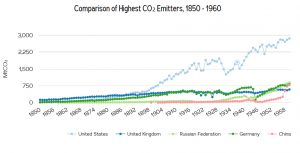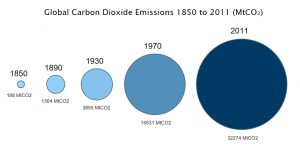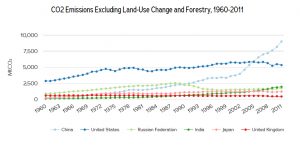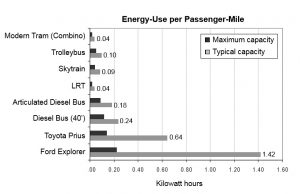Introduction:
Atmospheric CO2 Emission is a major climatic driver of global warming. Tracing back to the trajectory of Earth, the global concentration of CO2 in the atmosphere has been fluxing since the Ice Age. (Anderson et al., 2001, pg. 112) However, not until the 20th century did atmospheric CO2 become a risk to the human race, due to the stark incline of anthropomorphic CO2 emission caused by globalization and the massive consumption of fossil fuel. This consumption pattern has amplified greenhouse effect dramatically, leading to a global temperature rise of “0.6oC by the end of 20th century”. (Ibid.) Before diving into any deeper analysis, it is worth to clarify that Greenhouse Effect, “An effect occurring in the atmosphere because of the presence of certain gases that absorb infrared radiation”, by itself is not harmful to the human environment. (Rennie, 2016) It is also worth to note that CO2 is not an atmospheric pollution source; rather, it is a non-toxic gas layer that promotes photosynthesis, carbon sequestration and many other ecological functions. (CO2 Science.org, 2011) This essay is an attempt to summarize the developing concern of atmospheric CO2 emission, its implications, and the potential responses as a society. Using hybrid car technology as a case study, this essay will analyze the benefits and implications of our society’s current response to increasing atmospheric CO2 emission.
Atmospheric CO2, a brief history:
The existence of atmospheric CO2 can be traced back to as far as 420,000 years before present by retrieving data from the ice cores. (Blunier, Monnin and Barnola, 2005, pg. 62) According to the Volstok long term records, there is a “consistent pattern of glacial-interglacial CO2 changes over the past four climatic cycles”. (Ibid.) The naturally constant increase and decrease of CO2 concentration is not recent process, rather, “it is likely that the CO2 increase started before a large northern hemispheric warming for each termination”. (Ibid.) However, according to Blunier, Monnin and Barnola (2005), the long term process of CO2 concentration increase in nature had relatively “low time resolution”, and is smoothed “by the gas occlusion process”. (pg. 62)
As the human race evolves and proceeds into industrialization, the atmospheric CO2 concentration produced by anthropogenic activities increases rapidly. Early industrialization is a result of the development of steam-powered machineries, which requires massive consumptions of wood and coal fuel. One compound that yields from the combustion of coal or wood is CO2, which is then massively emitted into the atmosphere via pipes, chimneys and other industrial structures. The figure below, retrieved from World Resource Institute’s Climate Data Explorer, shows the relative growth of atmospheric CO2 emission of several major countries from the 1850s to 1960s.

Figure 1
It is easy to observe that the increase in CO2 emission correlates with the development of industrialization and history. An example is the dramatic drop in America’s CO2 emission between 1928 and 1934, where the great depression and the dust bowl have shut down many America’s industry and economic growth. Another example is the simultaneous increase and decrease of America and Germany during the WWII. War has provided America with massive industrial developments, leading to a massive growth in CO2 emission, while dragging Germany into a recession and yielding the contrary of America’s CO2 emission. According to World Resources Institute, the CO2 emission “were 150 times higher in 2011 than they were in 1850”. (Damassa and Friedrich, 2014) Figure 2 demonstrates the relative size of anthropogenic CO2 emission produced from 1850 to 1960.

Figure 2
Stepping into the present, as the Cold War marches to its end, new leading emitters start to emerge.

Figure 3
As the Global Resources Institute suggests, despite the fact that America still remains its leading position in CO2 emission, many European countries have stabled their CO2 emissions (Damassa and Friedrich, 2014). However, the economic growth in Asia has also made it a new major CO2 emission machine. Within them, China had the most significant contribution due to its various periods of aggressive industrialization and the economic reform in 1978. Meanwhile, GRI claims that the developed countries still maintain a high level of CO2 emission, despite the fact that their emission rates are reaching an equilibrium. (Ibid.)
Currently, many countries have realized the consequences that CO2 emission have caused to the living environment for human, and have came up with goals and plans for response. In 1997, the Kyoto Protocol was adopted in order to reduce Carbon emission. It was a “significant protocol to the international Framework Convention on Climate Change with the objective of reducing greenhouse gases that cause climate change.” (Vasser, 2009, pg.vii) The protocol divided countries into two types, Annex and non-Annex countries. The Annex countries are limited in Carbon emission, while the non-Annex countries may invest in low-carbon projects to earn Carbon credits and trade them to Annex countries. (Ibid.) Many have criticized the structure of Kyoto Protocol to be a “Top-bottom” approach, yielding less efficiency in reaching the goals of reducing Carbon emission. However, it is still an important agreement among countries that work together towards a low-carbon future.
In 2015, “195 countries agreed on a plan to reduce CO2 and other [GHG], aiming to limit global temperature increase well below 2oC”. (Anderson et al., 2016, pg.178) This is an ambitious goal, since the global temperature rise, according to Anderson et al., (2016), has already risen 0.6oC relative to pre-industrial climate. (pg.178) However, the latest model that projects temperature growth caused by greenhouse effect indicates that by the end of 21st century, the temperature rise will be between “1.0oC and 3.7oC”. (Anderson et al., 2016, pg. 179) Therefore, there is both hope and pressure in the future trajectory of temperature increase, which depends on people’s lifestyles that can either produce more or less carbon footprint.
Society’s responses towards low-carbon development:
As the society realizes the urgency of low-carbon developments, technology improvements in various aspects of our built environment emerges. One example is the It LEED certificate in architecture design, which is defined as a measurement in architecture design that “obligates participating actors to source and use building materials and design structures in ways that reduce their environmental impact, energy consumption and water use.” (Sandoval and Prakash 2016) Many LEED examples are visible on the UBC campus, such as the CIRS building, and the Buchanan Complex.
Another major technological improvement that is popular currently is in the field of automobiles, where major car manufacturers like GM, Ford and Toyota starts to invest into the field of Hybrid Automobile. The next section of this essay attempt to analyze the approach, and the efficiency of hybrid cars as a response to the increasing Carbon emission.
Toyota Prius: A Case Study:
Toyota Prius is a hybrid car that runs on both a petro and electrical motor, aimed to reduce and smooth the CO2 emission problem. It is a product of Japan’s policy on automobile emission regulation, which “encouraged the related industries to meet the new standards by giving them different incentives.” (Debnath, 2015, pg. 328). As it hits both Japanese and Foreign markets, it becomes popular with its “advantages of good mileage, travelling performance, ultra-low-emission and silence.” (Ibid.) It runs on a smooth, efficient engine, and is made of eco-plastics as claimed by Toyota officially. All of these features of Prius are designed, as suggested by Debnath (2015), is to ultimately reduce carbon emission.
The Prius is successful both economically and ecologically. According to Debnath (2015), the sale of Prius is exponentially growing since its debut in 1997. (pg. 328) As a result, the total CO2 emission that can be reduced by Toyota Priuses is about 4,500,000 tons compared to that of petro-powered cars. (Toyota Annual Report, 2008)
Therefore, as a response to the increasing CO2 emission, Toyota Prius is a extremely successful model. However, it is also worth to note that as a response, the Toyota Prius approach also has its implication. By switching the power mode of private automobiles, the problem of massive suburbanization is not solved. Rather, people may fall into Jevon’s Paradox, where more energy-efficient vehicles may actually lead people to drive more, walk less and increase the reliance of private automobile, because driving Plug-In hybrids is less sinful.
Meanwhile, by considering the reduce in carbon emission created by hybrid cars, the source of electricity also needs to be addressed. The electricity that is used to charge these hybrid cars produces more CO2 emissions if it comes from a coal plant.
A study by The Design Centre of Sustainability at UBC looks at the energy consumption per passenger-mile of different mode of transportation. From the figure below one may see that despite consuming less energy than a full-size SUV, by typical use the Prius still consumes much more than the public transit system.

Figure 4
Meanwhile, driving style also makes a difference. Running on full throttle most of the time consumes more energy in most of the cases.
Conclusion:
Atmospheric CO2 is a fundamental part of the atmospheric layer that covers the Earth. Since the Ice Ages, the concentration of CO2 has been fluctuating. However, as the human race proceeds into industrialization, the excessive CO2 emission has amplified greenhouse effect, which causes global warming and places pressure on the society. The emission rate is increasing in general, but varies nation by nation and is most evident in the global North. As a result, many countries have adapted agreements and regulations to reduce carbon emission, and have made significant process.
References:
Anderson, T. R., Hawkins, E., & Jones, P. D. (09/01/2016). Endeavour (new series): CO2, the greenhouse effect and global warming: From the pioneering work of arrhenius and callendar to today’s earth system models Elsevier. doi:10.1016/j.endeavour.2016.07.002
Condon, P. M. (n.d.). A Cost Comparasion of Tranportation Modes. Retrieved from Design Centre of Sustainability at UBC website: http://www.sxd.sala.ubc.ca/8_research/sxd_frb07transport.pdf
Debnath, S. C. (2015). Environmental regulations become restriction or a cause for innovation – A case study of toyota prius and nissan leaf. Procedia – Social and Behavioral Sciences, 195, 324-333. doi:10.1016/j.sbspro.2015.06.360
Ehleringer, J. R. (2005). A history of atmospheric CO₂ and its effects on plants, animals, and ecosystems Springer
Fredrich, J. R., & Damassa, T. (2014, May 21). The History of Carbon Dioxide Emissions. Retrieved November 20, 2016, from World Resources Institute website: http://www.wri.org/blog/2014/05/history-carbon-dioxide-emission
greenhouse effect (2016). (7th ed.) Oxford University Press
Monnin, E., Indermühle, A., Dällenbach, A., Flückiger, J., Stauffer, B., Stocker, T. F., . . . Barnola, J. (2001). Atmospheric CO2 concentrations over the last glacial termination. Science, 291(5501), 112-114. doi:10.1126/science.291.5501.112
Sandoval, P., & Prakash, A. (2016). Environmental policy and governance: The gold rush: The popularity of theGoldTier in leed certification ERP Environment. doi:10.1002/eet.1724
Toyota Annual Report 2008. (n.d.). Retrieved from Toyota Global website: http://www.toyota-global.com/pages/contents/investors/ir_library/annual/pdf/2008/pdf/p04_05.pdf
Vasser, C. P. (2009). The kyoto protocol economic assessments, implementation mechanisms, and policy implications Nova Science Publishers.